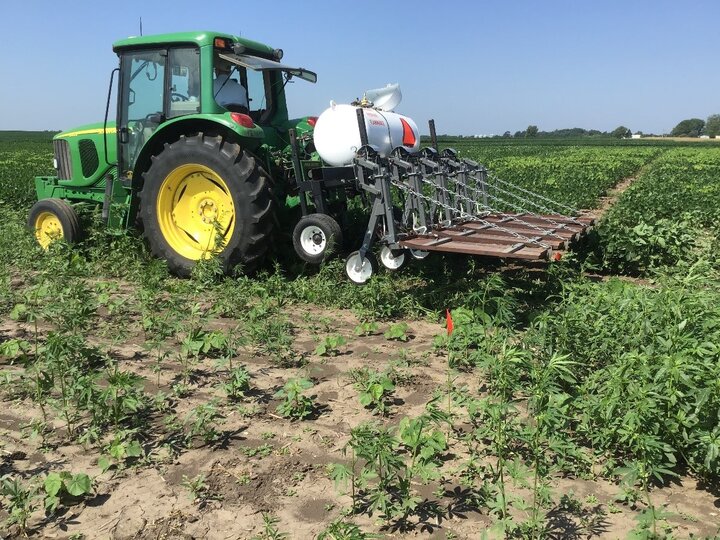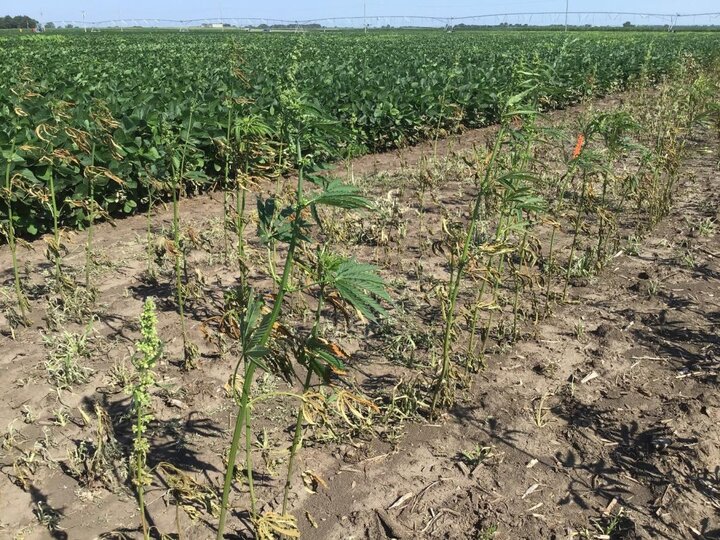With the legalization of various hemp types across the United States, there is also interest in organic (chemical-free) production of hemp. This is especially true for those hemp types that are grown for various oils, for pharmaceutical and medical use, where chemical residues are not allowed. Weed control without chemicals can be challenging, however, one method of weed control that leaves no chemical residues in plants, soil or water is commonly known as flame weeding.
Hemp Herbicide Tolerance Series
- Industrial Hemp Tolerance to Soil-applied Herbicides
- Industrial Hemp Varieties Exhibit the Same Tolerance Level to PRE-Herbicides
- Industrial Hemp Tolerance to Early-POST Herbicides
- Industrial Hemp Tolerance Late-POST Herbicides
Flame weeding is an acceptable weed control option in organic production. Flame weeding controls weeds by heating plant tissue which results in boiling water inside the cell, break-up of the proteins and ultimately the tissue death.
Based on our previous research, we have determined the tolerance level of six major agronomic crops to propane flaming. We have also determined how various weed species respond to broadcast flaming and that the propane rate of 10-12 gallons per acre was highly effective in controlling many weed species. For more information about flaming procedures check the Propane-Fueled Flame Weeding section of the 2020 Guide for Weed, Disease and Insect Management in Nebraska. Therefore, during the 2020 season we conducted a preliminary study at the Agronomy Farm by Mead, NE, with the objective of testing hemp tolerance to heat produced by flaming.
Industrial hemp (variety X-59 for fiber) was planted on June 8, 2020 in 30-inch rows, 0.5 inches deep and at about 20 thousand seeds per acre (10lbs/acre). A Total of five propane rates were applied to 18-24 inch tall hemp using a 4-row custom built flamer for research purposes (Photo 1). The rate structure was based on selecting a few rates above and below the recommended rate of 10 gal/acre (GPA), including 3, 6, 9, 12 and 15 GPA. The study was arranged in the randomized compete block design with 3 replications with 30-foot plots. Hemp injury ratings were conducted at 1, 7, 13, and 21 days after treatment (DAT) utilizing the scale from 0-100 (0=no injury; 100=dead plant). Weed control ratings were also conducted at 7 and 21 DAT. The study was terminated after the last rating.

Results
Hemp exhibited relatively good tolerance to most of the tested propane rates. Visual injury levels ranged from 10-70% depending on the propane rate and time of rating. The highest injury rating (76%) was evident at 7 DAT in the plots treated with the highest propane rate (15 GPA). The recommended propane rate (10 GPA) caused about 40-60% injury at 7 DAT but only 20-30% injury by 21 DAT. This indicates that hemp injury was temporary in nature, which was evident in the form of leaf browning on the base of the plants, while the new growth was not affected. The transient nature of injuries suggests that flaming has potential for use in hemp after crop emergence (post-emergent).
| Propane rate (gallons/acre) | 1DAT | 7 DAT | 13 DAT | 21DAT |
|---|---|---|---|---|
| 1. Propane rate of 15 | 50 | 76 | 40 | 26 |
| 2. Propane rate of 12 | 50 | 68 | 40 | 26 |
| 3. Propane rate of 9 | 47 | 40 | 43 | 30 |
| 4. Propane rate of 6 | 30 | 30 | 20 | 20 |
| 5. Propane rate of 3 | 20 | 20 | 20 | 13 |
Weed control was excellent (Photo 2) with any of the three top propane rates (9, 12, or 15 GPA) (Table 2). Waterhemp and velvetleaf were both sensitive to heat, which was evident by control ratings of 85% at 7 DAT and 100% at 21 DAT (Table 2). Green foxtail was suppressed well (80%) at 7 DAT, however there was only 30% at 21 DAT, indicating much regrowth and recovery of the foxtail plants by 21 DAT. In such a situation, a second flaming can be conducted.

| Propane rate (gallons/acre) | ------ 7 DAT ----- | ---- 21 DAT ----- | ||||
|---|---|---|---|---|---|---|
| VVL | WH | GF | VVL | WH | GF | |
| 1. Propane rate of 15 | 95 | 95 | 90 | 100 | 100 | 30 |
| 2. Propane rate of 12 | 98 | 87 | 80 | 100 | 100 | 30 |
| 3. Propane rate of 9 | 93 | 87 | 80 | 93 | 98 | 30 |
| 4. Propane rate of 6 | 50 | 50 | 50 | 33 | 33 | 30 |
| 5. Propane rate of 3 | 35 | 33 | 33 | 27 | 27 | 20 |
Conclusion
Hemp exhibited relatively good tolerance to heat from propane flaming. Temporary injury could be considered acceptable since it was only at the base of the plants and lasted only for about two weeks (Photo 3). As expected, flaming provided excellent control of broadleaf weeds, while grasses may require multiple flaming treatments.

